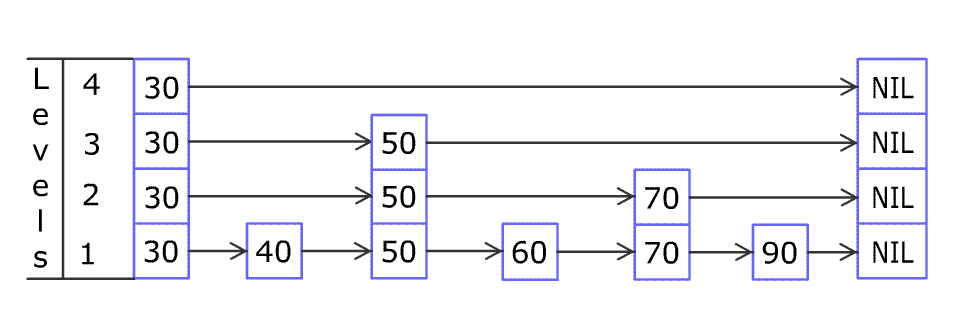1
2
3
4
5
6
7
8
9
10
11
12
13
14
15
16
17
18
19
20
21
22
23
24
25
26
27
28
29
30
31
32
33
34
35
36
37
38
39
40
41
42
43
44
45
46
47
48
49
50
51
52
53
54
55
56
57
58
59
60
61
62
63
64
65
66
67
68
69
70
71
72
73
74
75
76
77
78
79
80
81
82
83
84
85
86
87
88
89
90
91
92
93
94
95
96
97
98
99
100
101
102
103
104
105
106
107
108
109
110
111
112
113
114
115
116
117
118
119
120
121
122
123
124
125
126
127
128
129
130
131
132
133
134
135
136
137
138
139
140
141
142
143
144
145
146
147
148
149
150
151
152
153
154
155
156
157
158
159
160
161
162
163
164
165
166
167
168
169
170
171
172
173
174
175
176
177
178
179
180
181
182
183
184
185
186
187
188
189
190
191
192
193
194
195
196
197
198
199
200
201
202
203
204
205
206
207
208
209
210
211
212
|
/**
* 基于上下左右指针结构的跳表
*
* @author dragonsong @date 2022/6/28
*/
public class SimpleSkipList2<K extends Comparable<K>, V> {
/**
* 头节点位于跳表最左上,为查询起点
*/
Node<K, V> head;
/**
* k-v 个数
*/
int size;
/**
* 生成数据的最大层数
*/
int maxLevel;
public SimpleSkipList2() {
head = new Node<>(MAX_LEVEL);
Node<K, V> curr = head;
// head每层都生成
while (curr.level != 0) {
Node<K, V> lower = curr.copyWithLowerLevel();
curr.down = lower;
lower.up = curr;
curr = curr.down;
}
size = 0;
maxLevel = 0;
}
V get(K key) {
Node<K, V> node = getNode(key);
if (node == null || node.key == null || node.key.compareTo(key) != 0) {
return null;
}
return node.val;
}
/**
* @param key 待查找的key
* @return 查找链表中等值元素,或者查找链路上的prev前序节点
*/
Node<K, V> getNode(K key) {
Node<K, V> curr = head;
while (curr != null) {
// 先同层往右走
Node<K, V> next = curr.next;
if (next == null) {
// 只有head的情况
if (curr.down == null) {
return curr;
}
curr = curr.down;
} else {
// 已经有数据插入的情况
// 先同层向右找
while (next != null && next.key.compareTo(key) <= 0) {
curr = next;
next = next.next;
}
// 无down节点时,返回待插入位置的前序节点
if (curr.key != null && curr.key.compareTo(key) == 0 || curr.down == null) {
return curr;
}
// 再往下走
curr = curr.down;
}
}
return null;
}
void put(K key, V val) {
Node<K, V> prev = getNode(key);
if (prev == null) {
throw new IllegalStateException();
}
if (prev.key != null && prev.key.compareTo(key) == 0) {
// 存在:直接更新
prev.val = val;
return;
}
int level = SkipListLevelUtils.genRandomLevel();
maxLevel = Math.max(level, maxLevel);
while (prev.level > 0) {
prev = prev.down;
}
Node<K, V> down = null;
// 从0往上创建
for (int i = 0; i < level; i++) {
Node<K, V> newNode = new Node<>(key, val, i);
insertHorizontal(prev, newNode);
insertVertical(down, newNode);
down = newNode;
// 寻找下一个prev,有上取上,无上往回倒
while (prev.up == null) {
prev = prev.prev;
}
prev = prev.up;
}
++size;
}
/**
* 纵向插入
*
* @param down 下面的节点
* @param newNode 新节点
*/
private void insertVertical(Node<K, V> down, Node<K, V> newNode) {
if (down == null) {
return;
}
newNode.down = down;
down.up = newNode;
}
/**
* 横向插入
*
* @param prev 原前序节点
* @param newNode 新节点
*/
private void insertHorizontal(Node<K, V> prev, Node<K, V> newNode) {
Node<K, V> prevNext = prev.next;
prev.next = newNode;
if (prevNext != null) {
prevNext.prev = newNode;
}
newNode.next = prevNext;
newNode.prev = prev;
}
/**
* 逐层打印跳表结构
*/
public void print() {
Node<K, V> start = head;
while (start.level > maxLevel) {
start = start.down;
}
System.out.println("maxLevel:" + maxLevel);
Node<K, V> curr;
while (start != null && start.level >= 0) {
System.out.println("当前层数:" + start.level);
curr = start;
while (curr != null) {
System.out.print(curr + "-->");
curr = curr.next;
}
System.out.println();
start = start.down;
}
}
/**
* 链表节点
*
* @param <K> 键类型,可排序
*/
static class Node<K extends Comparable<K>, V> {
/**
* 保存的键类型
*/
K key;
/**
* 保存的值类型
*/
V val;
/**
* 层数
*/
int level;
/**
* 上下前后节点引用
*/
Node<K, V> prev, next, up, down;
public Node(int level) {
this.level = level;
}
public Node(K key, V val, int level) {
this.key = key;
this.val = val;
this.level = level;
}
public Node<K, V> copyWithLowerLevel() {
return new Node<>(this.key, this.val, this.level - 1);
}
@Override
public String toString() {
return "Node{" + "key=" + key + ", val=" + val + '}';
}
}
}
|
